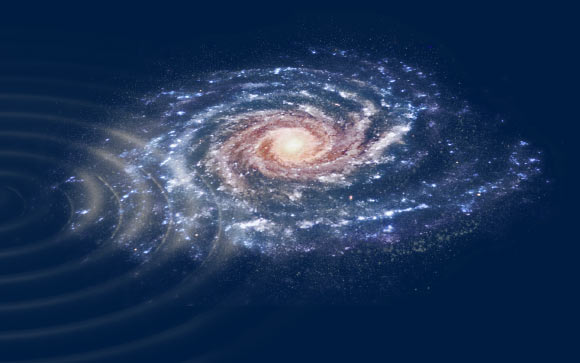Astronomers analyzing data from the second release of ESA’s star mapping mission Gaia have shown that our Milky Way Galaxy is still enduring the effects of a near collision that set millions of its stars moving like ripples on a pond. The close encounter likely took place sometime in the past 300-900 million years, and the culprit could be the Sagittarius dwarf galaxy, an elliptical loop-shaped galaxy located 78,300 light-years away. It was discovered because of the pattern of movement it has given to stars in the Milky Way disk.
“The pattern was revealed because Gaia not only accurately measures the positions of more than a billion stars but also precisely measures their velocities on the plane of the sky,” said Universitat de Barcelona astronomer Teresa Antoja and colleagues.
“For a subset of a few million stars, Gaia provided an estimate of the full 3D velocities, allowing a study of stellar motion using the combination of position and velocity, which is known as phase space.”
“In phase space, the stellar motions revealed an interesting and totally unexpected pattern when the star’s positions were plotted against their velocities.”
Dr. Antoja and co-authors analyzed the motions of six million stars in the Milky Way disk.
The analysis revealed a snail shell-like pattern in the graph that plotted the stars’ altitude above or below the plane of the Galaxy against their velocity in the same direction.
“It is a bit like throwing a stone in a pond, which displaces the water as ripples and waves,” Dr. Antoja noted.
Unlike the water molecules, which settle again, the stars retain a ‘memory’ that they were perturbed. This memory is found in their motions. After some time, although the ripples may no longer be easily visible in the distribution of stars, they are still there when you look in their velocities.
“We looked up previous studies that had investigated such ‘phase mixing’ in other astrophysical settings and in quantum physics situations,” the astronomers said.
“Although no one had investigated this happening in the disc of our Galaxy, the structures were clearly reminiscent of each other.”
“I find this really amazing that we can see this snail shell shape. It is just like it appears in text books,” said Professor Amina Helmi, a researcher at the University of Groningen in the Netherlands.
So the next question was what had ‘hit’ the Milky Way to cause this behavior in the stars.
“We know that our Galaxy grows by eating smaller galaxies and clusters of stars that then mix in with the rest of the Galaxy. But that didn’t seem to be the case here,” the scientists said.
“We recalled our own and others studies of the Sagittarius dwarf galaxy. This small galaxy contains a few tens of millions of stars and is currently in the process of being cannibalized by the Milky Way.”
“Its last close pass to our Galaxy was not a direct hit — it passed close by. This would have been enough so that its gravity perturbed some stars in our Galaxy like a stone dropping into water.”
“The clincher was that estimates of Sagittarius’s last close encounter with the Milky Way place it sometime between 200 million and one billion years ago, which is almost exactly what we calculated as an origin for the beginning of the snail shell-like pattern.”
“So far, however, the association of the snail shell feature with the Sagittarius dwarf galaxy is based on simple computer models and analyses. The next step is to scrutinize the phenomenon more fully to gain knowledge of the Milky Way.”
The research was published in the September 19, 2018 issue of the journal Nature.
Source: Sci News

































Leave a Comment
You must be logged in to post a comment.